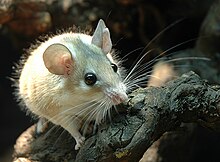| Eastern spiny mouse | |
|---|---|

| |
| Conservation status | |
 Least Concern (IUCN 3.1) | |
| Scientific classification | |
| Domain: | Eukaryota |
| Kingdom: | Animalia |
| Phylum: | Chordata |
| Class: | Mammalia |
| Order: | Rodentia |
| Family: | Muridae |
| Genus: | Acomys |
| Species: | A. dimidiatus |
| Binomial name | |
| Acomys dimidiatus (Cretzschmar, 1826) | |
| Synonyms | |
|
Acomys cahirinus dimidiatus | |
The eastern spiny mouse or Arabian spiny mouse (Acomys dimidiatus) is a species of rodent in the family Muridae. They have a wide range, having been found in Middle Eastern deserts, as well as being prevalent in riverine forests in Africa. This is the only species of spiny mouse which may have black coloration. Their diet is similar to other species of spiny mouse, consisting mostly of seeds.
Description

The eastern spiny mouse is a small rodent with a head-and-body length of up to 17.5 cm (7 in) and a tail of up to 12.5 cm (5 in), and a maximum weight of about 90 g (3.2 oz). The fur feels coarse when rubbed against the lie of the hairs, each individual hair being dark tan with a greyish tip. The tail appears naked but is in fact clad with short bristles.
Distribution
This mouse has a wide distribution in the Middle East, its range extending from the Sinai Peninsula, through Lebanon, Syria, Jordan and Israel, to the Arabian Peninsula, southern Iraq, southern Iran and southern Pakistan. It occurs in semi-arid or arid regions, in dry forests, scrubby and rocky areas at altitudes of up to 1,200 m (3,900 ft). It can be present in agricultural land and sometimes invades houses.
Ecology

The species is nocturnal, avoiding the heat of the day and foraging at night for seeds, and sometimes insects and grasses. It is a sociable animal and lives in small groups. Females become mature at about two months of age and can produce litters of up to five young after a gestation period of about 42 days. Another female in the family group may help with care of the young, which are weaned after about a fortnight.
Its spiny hair may help to prevent predation, perhaps making the animal harder to swallow, and this mouse is also capable of shedding its tail in order to escape from a predator. In captivity, this mouse can live for five years, but three years may be a more realistic life expectancy in the wild.
Status
The eastern spiny mouse is common throughout most of its range. It is adaptable and no particular threats have been identified, so the International Union for Conservation of Nature has listed its conservation status as being of "least concern".
References
- ^ Cassola, F. (2017) . "Acomys dimidiatus". IUCN Red List of Threatened Species. 2016: e.T136471A115208221. doi:10.2305/IUCN.UK.2016-3.RLTS.T136471A22453198.en. Retrieved 8 March 2022.
- Musser, G. G.; Carleton, M. D. (2005). "Superfamily Muroidea". In Wilson, D. E.; Reeder, D. M. (eds.). Mammal Species of the World: A Taxonomic and Geographic Reference (3rd ed.). Johns Hopkins University Press. p. 1196. ISBN 978-0-8018-8221-0. OCLC 62265494.
- Atallah, Sana I. (May 1967). "A New Species of Spiny Mouse (Acomys) from Jordan". Journal of Mammalogy. 48 (2). Journal of Mammalogy, Vol. 48, No. 2: 258–261. doi:10.2307/1378029. JSTOR 1378029.
- Varty, Nigel (May 1990). "Ecology of the Small Mammals in the Riverine Forests of the Jubba Valley, Southern Somalia". Journal of Tropical Ecology. 6 (2): 179–189. doi:10.1017/S0266467400004272.
- ^ "Arabian spiny mouse". ARKive. Archived from the original on 2016-10-09. Retrieved 12 August 2016.
| Taxon identifiers | |
|---|---|
| Acomys dimidiatus | |
| Mus dimidiatus | |